Riverpath puts Warkworth in league of its own
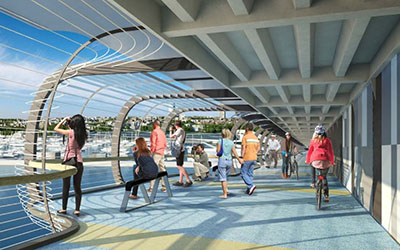
Mahurangi imagined in 2029
The following future-imagining does not necessarily reflect the opinions or aspirations of those persons or companies quoted or cited.
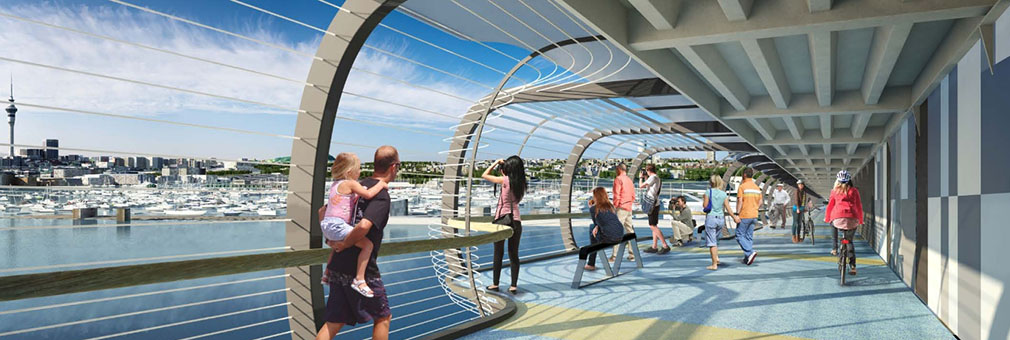
First there was Skypath: Few Aucklanders realised that their much-cherished Skypath was masterminded not from the city, but from a small office in the satellite town of Warkworth, 58 kilometres north. By happy coincidence, project director Bevan Woodward was working in a town that was also home to world-leading composites exponents, Core Builders Composites, and it was their lightweight, low-maintenance span design that made Skypath a reality, and Auckland a mecca for a new breed of actual ecotourists. Without the precedent of Skypath, the Mahurangi Riverpath would never have materialised—sunk by the projected maintenance costs, and short working life, expected of traditional building materials. Riverpath proved to be for Mahurangi, what Skypath was to the city. image Skypath
If measured in leagues, it’d be fewer than 1.3 of them. While it can take an eternity by road, particularly in holiday traffic, the six-kilometre path between Warkworth and Snells Beach, following the Mahurangi River, takes cyclists an average of about 25 minutes.
Many comment it invariably feels like a lot less than that, in the tranquillity, free of frenetic traffic alongside. Occasionally though, a walker or cyclist is delayed, when the Craigieburn Bridge is swung open to allow passage of a yacht heading to or from the town basinor to or from the Robertsons’ renowned boat yard—now transformed and much visited thanks to the long-mooted dredging programme finally getting underway. Others tarry at the Turnbridge Café in the hope of seeing a sufficiently lofty or bulky vessel hove into view to require the span to be opened.

Playing to its Strengths: As one of New Zealand’s most important sites of industrial archaeology, the Wilson Cement Works, just a third of a league downstream, is, second only to the Mahurangi River and its near-miraculous backdrop of indigenous forest, the town’s greatest asset. For that reason alone, there was no question that the Mahurangi Riverpath had to follow the western riverbank at least as far as that point. oil on hardboard Peggy Spicer
When, nearly 20 years agofor the purposes of this harmless bit of future-imagining, the year is 2029, the new Auckland Council was established and immediately ordained that Warkworth was to become a satellite growth centre, no thought was given to the possibility that, what essentially was going to be a new town, might be any different than those New Zealanders were all-too familiar with—where first and foremost, the car would be catered for, with hectares of tar-sealed surface, and two- and three-car garage doors the main architectural feature. But in Mahurangi, something unique happened. The townspeople insisted that it was their turn to call the shots. City hall, with its unitary plan, might have locked in growth for a five-times-bigger town, but if that was to be the case, Warkworthians resolved, it was going to be a rare and beautiful one—a place that put people first.
The remarkable opportunity that was appreciated, just in time, was that the Mahurangi, in many respects, had got lucky. In the 1950s and ’60s, the then Rodney County Council was hell-bent of seeing every bit of its coastline subdivided. The county, like local bodies eternally, were hungry for income. More titles equalled more taxesto call a rates-spade a spade. But the plan was flawed; the more, disparate coastal settlements that were sanctioned, the greater was the demand for services such as wastewater treatment, that the council was required by law to provide. Panicked, the county council promptly pulled up the drawbridge on new coastal settlements, confining development to those areas where it was already in donkeyto cast no aspersions, of course, on the donkeys of Highfield Garden Reserve, between the coastal settlements of Snells Beach and Algies Bay deep. The net result was that Mahurangi avoided the bay-to-bay subdivision that has irretrievably blighted most of the coastline from the metropolis to Hatfields Beach. Whangaparāoa-isation averted.
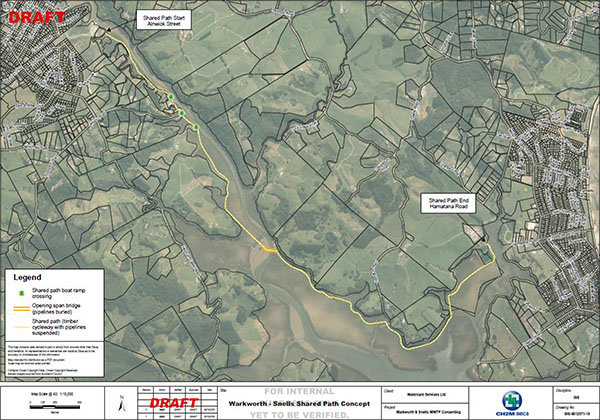
Path of Least Resistance: Although Watercare Services found that a path–pipeline would save on operational costs, and eliminate all the obtrusive pump stations, it initially concluded that consenting difficulties and high maintenance costs ruled out a Mahurangi River route. However, after Core Builders Composites and Morphum Environmental came up with a plan for a pathway that simply demanded to be built, regardless of whether it served as a conduit for the wastewater pipeline, the council-controlled organisation happily reviewed its earlier stance. Not shown on this early map were the several additional opening spans that are occasionally required for navigational access by property holders along the route. plan CH2M Beca
Without fresh thinking, the already five-times-larger Warkworth would have swamped the car parking of all the beaches handy to what is essentially a new town of 20 000 people, and not just after work or on the weekend. People who’d lived most of their lives in the area, would have felt strangers in their own community—chased away to quieter parts of the country, thereby often burdening family with long, dutiful drives. But Warkworth embraced a different future, and walking, cycling and using one of the many local shuttles is now second nature. What many didn’t anticipate was the sense of freedom that came with this new style of getting around, that left folk free to walk when they felt like it, and ride when they didn’t. Counterintuitively, the Mahurangi Riverpath made a river ferry service between Snells Beach and Warkworth viable—walking or cycling one direction, and riding the ferry home again, proved to be a winning combination.
Although the Mahurangi Riverpath was soon taken for granted, in the best possible way, it wasn’t always like that. Watercare Services had earlier ruled out a Mahurangi River route for its new Warkworth to Snells Beach wastewater pipeline, because the cost and consenting hurdles of burying a pipeline in the coastal marine area. Iwi opposition had also—incorrectly, as it transpired—been stated as a given. But working from the Warkworth office of an Australasian environmental consultancy was master geometric infrastructure designer Liam Callaghan, taking a break from designing motorways. Liam immediately saw the potential of a second, green, transport link to the Mahurangi Peninsula. His sinuous design perfectly respected the estuarine river form. And, once again, the Warkworth-based, world-renowned America’s Cup yacht builders, Core Builders Composites, came to the rescue of cycling and walking. It is their high-tech lightweight low-maintenance spans that form the Skypath, which was responsible for putting Auckland in the pantheon of world-class zero-carbon cities. When the company came up with a boardwalk design that provided Watercare Services with a cheaper alternative to the up-to $66 million it had allowed for laying just one of the two 400-millimetre wastewater pipelines that Warkworth has long-since needed, its previous reservations evaporated. A bonus for Mahurangi Peninsula people was that the notoriously busy Sandspit Road didn’t need to be disrupted once, much less twice, for what would have been prolonged and unpopular works.
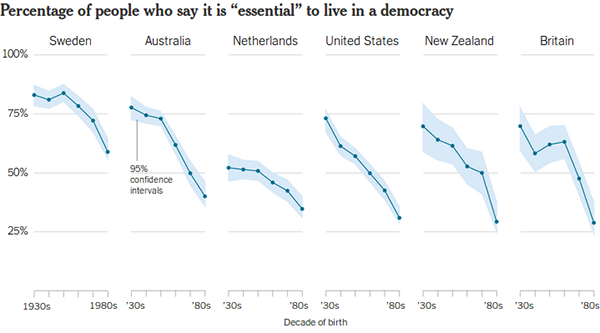
Back from the Brink: Back in 2016, after the reality of a populist demagogue being elected president of the United States sank in, suddenly much more notice was taken of the researchers who’d been warning that the collapse of democracy was not only possible, but well underway in a number of countries, not least of all Aotearoa. This chart came under criticism for being ‘alarmist’, in that it plots the percentage of respondents who ranked living in a democracy as ‘essential’ as 10. The chart does not display those who ranked the importance of living in a democracy less than 10 through 1—‘not at all important’. At the time, the Mahurangi Magazine commented that the percentage of young people ranking the importance of living in a democracy anything less than an unequivocal 10 was indeed cause for alarm, and for immediate action. source Yascha Mounk and Roberto Stefan Foa
But not only did Mahurangi—as the town is increasingly being called—benefit directly from its river path to the sea, with Core Builders Composites becoming the world authority on elevated path and cycleway infrastructure, even as it continued as the McLaren of high-tech sailing machines, Warkworth avoided the fate of becoming, predominantly, a dormitory and retirement town. The story of how cement manufacture, newspaper printing, and then composites tooling and manufacture successively replaced each other as the town’s biggest employer, and country’s leader in its field, is a saga in itself. Likewise, is the story about how an ill-conceived marron farming venture spawned an aquaculture and maritime technical institute. When John Anderson Brown founded the town, named for a village near his Northumberland birthplace, it is doubtful that he could have dreamed that 175 years on, in 2029, that it’s population would be five times greater than the much-vaunted castle town, and boast a veritable university—the Mahurangi Technical Institute having gone from strength to strength, having also become a world centre of excellence for civics and urban design.
Warkworth didn’t become a mecca for walking and cycling in isolation. Beyond the town, ambitious plans for a network of trails from Pākiri to Pūhoi and Wenderholm had just reached critical mass, melded into a cohesive whole with the help Auckland Council’s small but potent path and trails team. It was also no accident that, at the time, the two highest polling Warkworth subdivision members elected to the Rodney Local Board both headed local trails trusts. Tessa Berger, then a 22-year-old, chaired the Mahurangi Coastal Trail Trust, which had just helped with the successful, massively popular push to keep Te Muri—gem of the, now 1000-hectare, Mahurangi Regional Park—car free.
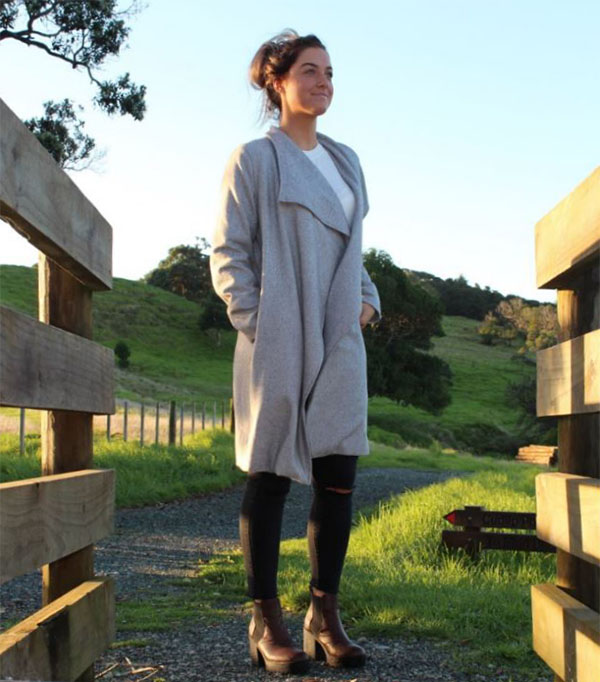
Boots and All: Prime Minister-elect Tessa Berger aged 21, as interviewed by the Junction, in that illustrious magazine’s first year of publication, and before Tessa had determined to kick-start her public office career by successfully standing for the former Rodney Local Board. Although it took until 2020 for it to happen, when New Zealanders eventually realised that the Fifth National Government deserved to be the party’s last, its popularity had plummeted from 50 to 20 percent in just three years. With this week’s polling showing National at 21%, the previous record low achieved under the leadership of Bill English in 2002, and the apparent terminal attrition of its membership base, many now doubt that the party has a future. image Caitlin Owston-Doyle | Junction magazine
What set Mahurangi development on its radically different trajectory was the initiative by Tessa and local planning consultant Burnette Macnicol whereby Warkworthians were urged to seize the opportunity for the satellite growth centre to be designed as a people-centred space. Burnette, now an urban design lecturer at the Mahurangi University, insists that the Berger factor was crucial:
It was during the brief but worrying rise of populist antiestablishmentism that had just witnessed Brexit. Disillusionment with democracy had seen Trump elected with only a quarter of the vote, and even here, our mayor attracted less than 18% of the registered voters. But when 22-year-old Tessa told the people of Mahurangi that is was up to them, and not to Auckland Council to decide what it wanted for the town, people suddenly felt empowered. They agreed that they didn’t want same-old-same-old. They wanted safe streets with room for mature trees, and space for paths and cycleways, with the Mahurangi River providing a continuous park that tied the whole town together, and linked the old with the new. People visiting are amazed that our grandkids swim in the river, it is now runs so clean. It took a young person to give a generation that had just about given up hope that the council could be made to listen the courage to create something unique.
In hindsight, the signal achievement of the Mahurangi community was learning that it was okay plan for a better future. By ignoring devices designed to discourage people from believing that they could shape their own destiny, a different path has been trodden. Fittingly, New Zealand’s four-term populist prime minister, John Key, is now best remembered, when he is remembered at all, by his infamous reaction to the treasury’s statements on the country’s long-term fiscal position:
I’m telling you it’s a load of nonsense, because they can’t get predictions in 44 days right, let alone in 44 years.
With his ranking amongst past prime ministers long since at rock bottom, it is now largely forgotten that Key still led his party to its last term of office, a full year after disingenuously conflating prediction and projection. But that was before Gareth Morgan’s Opportunities Party disrupted the parliamentary Tweedledum–Tweedledee that had done so much to discredit democracy. A key part of that disruption was the involvement of a surge of youthful parliamentarians, who succeeded, after decades of decline, in getting out the youth vote, and it was no accident that Tessa Berger, as the face of Kids Voting, built an enormous youthful constituency that now sees her, after a term away from Parliament as mayor of Auckland, prime minister-electyes, on becoming a republic, Aotearoa finally gained the courage to elect its own prime ministers, and governers-general, and New Zealand’s youngest, beating the record of the country’s possibly best prime minister to date, Edward Stafford, that had stood since 1856.
With Berger as prime minister, few doubt that climate mobilisation legislation introduced by the Opportunities Party late in the term of the 55th New Zealand Parliament, will now pass into law.

Love this editorial but let’s not give Tessa to the whole country … let’s keep her for our own, to protect and enhance the remaining natural areas of Rodney from the rampant developers. Let Rodney be a shining light to the country, and envious, they will want to imitate.
I love the idea of being able to walk safely, without being mown down by cars, or cyclists, (they were horrendous on the Camino in Spain!) to and from Sandspit, via Snells if necessary.
Thank you Francis, but not only is nice to share, we’ll need Tessa in the United Nations Parliamentary Assembly, when democracy finally catches up with globalisation.